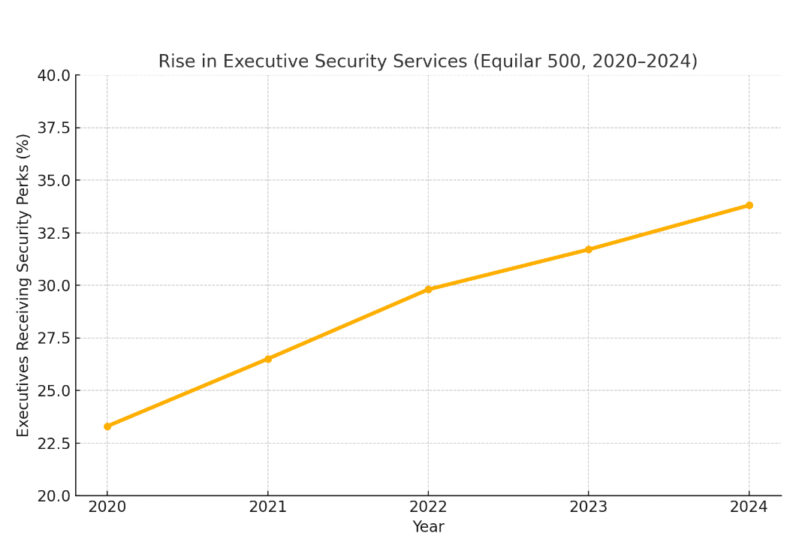From Perk to Priority: The Rise of Executive Security Services in Corporate America

Executive Summary
An in-depth analysis of security-related perks among the Equilar 500—the largest U.S. publicly traded companies by revenue—reveals a marked increase in the prevalence and cost of executive security benefits. From 2020 to 2024, the number of executives receiving security services rose sharply in response to escalating threats, culminating in a widespread corporate reassessment following the assassination of a Fortune 10 executive in late 2024.
Background
Corporate leaders are exposed to growing physical, digital, and reputational threats. Equilar’s study, based on proxy filings from 2020 through 2024, tracks how companies are responding by investing in security-related perquisites for named executive officers (NEOs), which include personal security details, residential surveillance, cybersecurity services, secure transportation, and related measures.
Key Statistical Findings
Growth in Prevalence
- In 2024, 33.8% of Equilar 500 executives received at least one security-related perk, compared to 23.3% in 2020—an increase of 45.1%.
- For CEOs specifically, the percentage rose from 29.5% to 43.7% over the same period, a 48.1% increase.
Sector-Specific Data
- Communication Services had the highest prevalence rate of security perks in 2024 at 65.0%.
- Technology Sector saw the most aggressive growth, with a 73.5% increase in prevalence from 2020 to 2024.
- Energy Sector remained relatively flat, ending at 25.8% in 2024—up just 0.5% from 2020.
Spending Trends
- Median security-related compensation for CEOs rose to $77,976 in 2024, compared to $50,693 in 2020.
- Median spend for CFOs rose to $12,370 in 2024, while other NEOs reached $35,225.
- Other NEOs experienced the largest spending growth at 196.5% over the five-year period.
- Some companies disclosed executive security spending exceeding $1 million annually.
- Broadcom disclosed spending $1.37 million for CEO Hock Tan.
- UnitedHealth Group reported $1.73 million in security costs for CEO Andrew Witty in 2024.
Impact of High-Profile Incidents
- The December 2024 murder of UnitedHealth Group’s CEO marked a critical inflection point.
- Following the incident, corporate security expenditures surged, and filings reflected a shift toward more robust disclosure of security services provided to executives.
- Additional companies, including Walmart and General Motors, disclosed substantial increases in executive protection costs in subsequent proxy statements.
Expanded Scope of Security Perks
- Beyond CEOs, more companies are extending protection to other members of the C-suite and to directors.
- New categories of spending include:
- Personal and residential security system upgrades
- Private travel with security coordination
- Social media monitoring and OSINT threat tracking
- Event security and advance threat assessments
- Cybersecurity enhancements including dark web monitoring
- The integration of digital and physical security protocols is becoming standard practice across multiple sectors.
Disclosure Practices
- The Securities and Exchange Commission (SEC) requires disclosure of perquisites if the aggregate value exceeds $10,000 and is deemed personal in nature.
- In light of growing shareholder scrutiny, companies are more frequently classifying security as a necessary business expense, reducing the likelihood that it will be reported as taxable income to executives.
- The nature and detail of proxy disclosures have grown in specificity, often outlining whether services include residential, travel, or cyber protection.
Conclusion
The Equilar data illustrate a clear and accelerating trend: corporate America is significantly increasing its investment in executive security. The five-year period from 2020 to 2024 saw substantial growth in both the number of executives receiving security perks and the dollar amounts allocated to these services. Industry-specific dynamics, combined with macro-level security concerns, suggest that these trends will likely continue as security becomes a normalized and critical function of executive compensation.
Citation:
Batish, Amit, and Joyce Chen. “Executive Security Perks: Evolving Trends in a New Era of Risk.” Harvard Law School Forum on Corporate Governance, July 22, 2025. https://corpgov.law.harvard.edu/2025/07/22/executive-security-perks-evolving-trends-in-a-new-era-of-risk/
